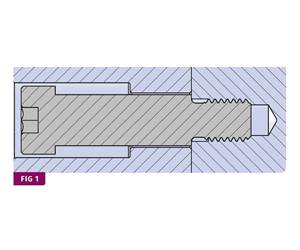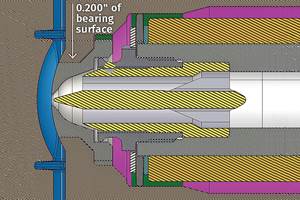Don’t Overlook Gate Location
Molders take heed: Gate location is the root cause of many molding difficulties. You’ll be doing yourself a big favor by spending some time and thought in determining the best gate location. Here’s what to look for.
Gate location can make or break your part design. Yet most CAD designers give little thought as to where to put the gate, or injectionpoint, on the part they design. They simply leave that detail to the moldmaker.
This is a big mistake. Along with choosing the wrong gate size and type (hint: don’t use a 1-mm diam. subgate for a large, glass-filled nylon or polycarbonate part), a less than ideal gate location is the root cause of many molding difficulties. If you designed the part, you own the part, and you’ll be doing yourself a big favor by spending some time and thought in determining the best gate location for it. Where the weld lines are, where the sink marks or voids will be, and how the part warps—all of these are determined by where the molten plastic is injected into the part cavity.
WHEN ONE IS BETTER THAN TWO
Take a look at Fig. 1. The designer who did this metal-to-plastic conversion thought he’d done everything right. He carefully chose the right material (20% glass-filled PBT). He did a computer finite-element analysis of his part design to make sure it could handle the required loads. And then he handed his CAD model off to the moldmaker.
The moldmaker—who is adept in machining tool steel, but knows very little about the flow of polymeric fluids—put two gates into this part. Only one gate was needed to fill this small part (about the size of your little finger), but if one gate is good, it stands to reason that two gates are better, right? Actually, no! Those two gates formed a weak weld line in the middle of this highly stressed part, resulting in its failure. Once those two gates were replaced with a single gate on the end, the part worked as designed.
My crude mock-up of a fan shroud design in Fig. 2 demonstrates the thought process you need to go through when determining gate location. The designer designed the louvers to be vertical, and wanted to gate the part in the center, hiding the gate mark with a company logo cemented on top. The problem with this scheme is the formation of very weak weld lines in the middle of all the louvers, which would easily snap in half under impact. The solution is to either rotate the louvers 90° or, if the louver design can’t be modified, change to multiple gates along the edge of the part.
An ideal injection molded plastic part should have a uniform nominal wall thickness; however, sometimes the end-use requires thick and thin areas.
If that is the case with your part, try to gate into the thickest area, and avoid gating into a thin area. Failure to do so can result in voids (many folks think they’re air bubbles, but they’re really shrink-induced voids) or sink marks. The best packing occurs at the gate, and you need the best packing you can get at a thick section to avoid these defects.
Gate location also affects the orientation of the polymer molecules and how the part will shrink. Figure 3 shows that if a part is long and narrow and needs to be absolutely straight, then you need to gate it on the end. (You’ll never see an injection molded plastic ruler gated on the side, because people won’t buy rulers that don’t have a straight edge.)
If a part is round and needs to be absolutely round, then you need to gate it in the center. Of course many part designs can handle 0.005 to 0.015 in. of bow or out-of-roundness, but if your part can’t, then choose your gate location wisely.
ABOUT THE AUTHOR
Joe Henz is a chemical engineer with 30 years of experience in the plastics industry, primarily with GE. He now teaches courses in injection molding and plastic part design at the Polymers Center of Excellence and UNC-Charlotte in Charlotte, N.C.. Email him at jhenz@polymer-center.org or visit www.polymers-center.org.
Related Content
Why Shoulder Bolts Are Too Important to Ignore (Part 2)
Follow these tips and tricks for a better design.
Read MoreThree Key Decisions for an Optimal Ejection System
When determining the best ejection option for a tool, molders must consider the ejector’s surface area, location and style.
Read MoreHot Runners: Truths. Myths, Overlooked Areas: Part 2
Here’s a view from the trenches of a tooling manager who, over 30 years, has experienced the joys and pains of using virtually every type of hot runner on the market. Part 2.
Read MoreWhere and How to Vent Injection Molds: Part 3
Questioning several “rules of thumb” about venting injection molds.
Read MoreRead Next
See Recyclers Close the Loop on Trade Show Production Scrap at NPE2024
A collaboration between show organizer PLASTICS, recycler CPR and size reduction experts WEIMA and Conair recovered and recycled all production scrap at NPE2024.
Read MoreBeyond Prototypes: 8 Ways the Plastics Industry Is Using 3D Printing
Plastics processors are finding applications for 3D printing around the plant and across the supply chain. Here are 8 examples to look for at NPE2024.
Read MoreLead the Conversation, Change the Conversation
Coverage of single-use plastics can be both misleading and demoralizing. Here are 10 tips for changing the perception of the plastics industry at your company and in your community.
Read More
























